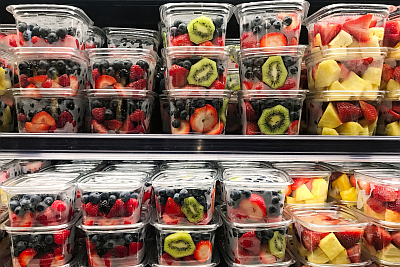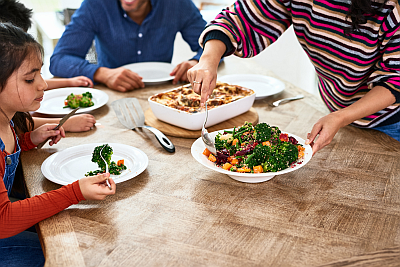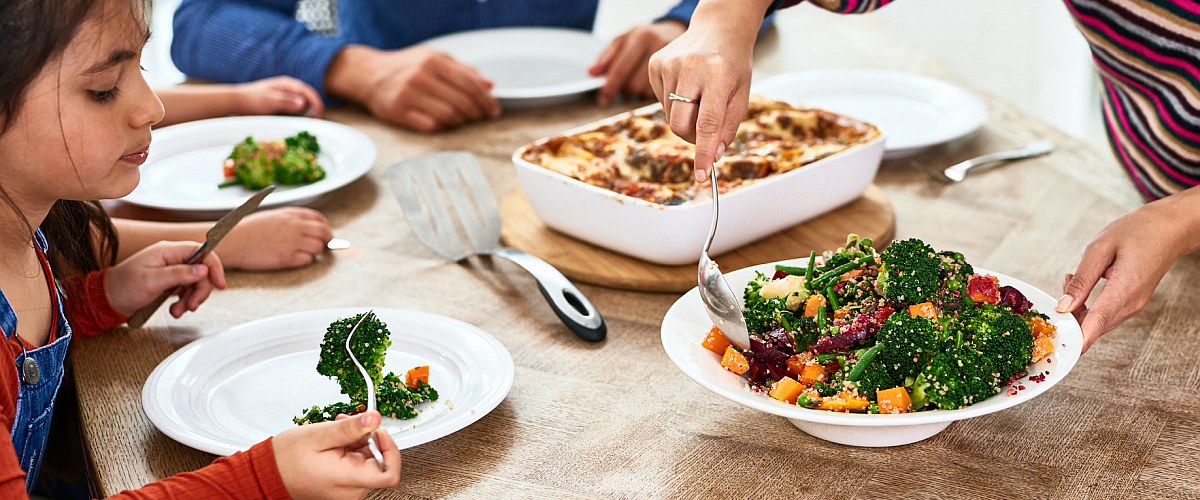It’s 6:00 p.m. on a weeknight and your family is home after a busy day. You’re tired from a long day of work and the kids are equally tired from school and after school activities.
Everyone’s hungry (and a little irritable)! And you have no concrete plans for dinner.

For many busy families, this scene is all too familiar. “Getting dinner on the table every night is tough,” assures David Murphy (pictured), executive chef for one of Aramark’s biggest school district clients. “It’s one thing to pledge to cook more and collect tons of recipes. It’s another thing to make those meals happen.”
That’s why meal planning is your secret weapon in answering that age-old question, “What’s for dinner?” We turned to Chef David for practical tips to make this part of your week a breeze.
WHY PLAN AHEAD?
The biggest upside to planning on the weekend is that it makes weekday mealtimes less stressful—no more scrambling at the end of a jam-packed day. And that’s only the beginning.
“Planning out your meals ahead of the busy week helps ensure variety, so you’re not serving the same things all the time,” adds the chef. It’s also a great way to meet your family’s general health goals.
Meal planning will make your bank account happy, too. “If you’re on a budget (and who isn’t?), meal planning is a sure-fire way to save money. Sticking to a plan with a well thought out shopping list usually means lower bills at the grocery store,” Chef David explains.
YOUR MEAL-PLANNING GAME PLAN
Ready to up your meal-planning game? Chef David has the following recommendations.
#1: Map Out Your Menus
Answering a few simple questions on a Saturday morning can help you build your weekly line-up. What healthy foods do you want to introduce your children to?Which ingredients in the fridge and pantry do you need to use up? What’s in season? (Pro trip: Seasonal produce often costs less.)
“This brainstorming with your children is the best part! It can get everyone excited for the week’s plan,” shares Chef David.
Setting aside 15-20 minutes to organize the week’s needs, following the example chart below, can make mapping out meals quick and easy:
| Day of the Week | Main Dish | Side Dish |
| Monday | Pasta | Broccoli or Green Beans |
| Tuesday | Roasted Chicken | Sweet Potatoes |
| Wednesday | Veggie Stir Fry | Cauliflower Rice |
| Thursday | Turkey Burgers | Tangy Kale Slaw |
| Friday | Fish Tacos | Guacamole |
#2: Keep Favorite Recipes Handy
Storing tried-and-true options at your fingertips will help you plan meals with ease. You could have a dog-eared cookbook collection, an old-school binder of clippings, or an online library of bookmarked recipes. The best method is the one that works for you.
“Fine-tune and personalize the recipes each time you make them,” Chef David advises. “That’s how they become family traditions.” (Looking for new healthy recipes? Our recipe page has dozens to try!)

Just because you’re the parent doesn’t mean you have to do all the work yourself. “Use this time to talk to your children about following a balanced diet,” says Chef David. “Remember, they’re looking to you as their role model for nearly everything.”
Ask each family member to pick one main course each week. That could be an old favorite, or something new they want to try. Another approach is to assign themes to certain weeknights. (Monday is Italian night, Wednesday is Mexican night, and so on.) Including the whole family will not only alleviate the pressure on you, but can teach important cooking skills your children will need to lead a healthy life.
#4: Stick to the Plan
Once you have your game plan, it’s time to go shopping. Chef David’s advice: Make a list, bring your list with you (!) and be intentional. “After all, what goes in your grocery cart or farmers’ market bag winds up on your plate at home.”

With every purchase, make sure it’s something you either have run out of at home or have a plan for in the coming days. This limits impulse buys—and, again, saves money. Take the children with you to help shop for bargains. If you children are older, divide and conquer the list. This isn’t to say you can’t be flexible. For example, if shrimp is on sale instead of chicken, switch things up. If the eggplants look really good, go for it.
Pro tip: Chef David reminds us that asking your children to help at the grocery store is a great way to get them more invested in the process.
#5: Buy and Cook in Bulk
With meal planning, it pays to think big. Buying certain ingredients in larger quantities can save both time and money.
“This goes for foods with a long shelf life,” he explains. “Whole grains like brown rice, steel-cut oats, barley, and whole-wheat pasta can be stored in your pantry for weeks or months at a time. And when properly done, bigger packages of chicken and even fruits and vegetables can be divided up and frozen for future use.”
Don’t be afraid to prepare big batches of staples, either—think rice, beans, chopped veggies, and seasoned ground meat. “Plan multiple meals around these ingredients, or freeze extras for later,” he suggests. “You can even share bulk ingredients with your neighbors—and will be ready to host one (or a few) of your kid’s friends for dinner!”
#6: Choose Convenience

Don’t have time to peel sweet potatoes? Hate crying over diced onions? Consider picking up pre-prepped ingredients at the store. Chopped fruits and veggies, portioned nuts, and grilled chicken strips can save you time and hassle. (Just watch for added oil, salt and sugar.) They also can contribute to healthy and quick snacks for your classroom warriors.
“Convenience products may cost a little more, but they are quite useful if you’re short on time,” Chef David shares. “If it makes the difference between you cooking at home and not, then it’s a good investment.”
Think about pre-prepped ingredients strategically. You probably wouldn’t want to use them every night, but have them ready to use a night or two each week when you really need the extra convenience.
#7: Have a Back-Up Plan
Sometimes the best-laid plans fall through. For extra busy nights, keep a variety of healthy ingredients on hand so you can whip something up on a moment’s notice.

“You can make quick, family-friendly dinners with a few key staples,” according to Chef David. “Whole-grain pasta and rice, oats, pasta sauce, canned veggies and beans, frozen non-breaded chicken breasts or fish fillets, and dried herbs and spices are all great starting points.”
ABC Meatball Soup and Butternut and Black Bean Chili with Quinoa are two tasty examples. Breakfast for dinner is a winning back-up plan, too!
PLANNING FOR SUCCESS
If your family is new to meal planning, you don’t have to go from zero to 60. Start with one or two nights a week and build up from there. Know that with every meal you plan, prepare, and share together, you’re helping your children build the foundation of a healthy life and be their best in school.
For more mealtime inspiration, check out our recipe page.
Note: Since everyone’s health history and nutritional needs are so different, please make sure that you talk with your doctor and a registered dietitian to get advice about the diet and exercise plan that‘s right for you.

